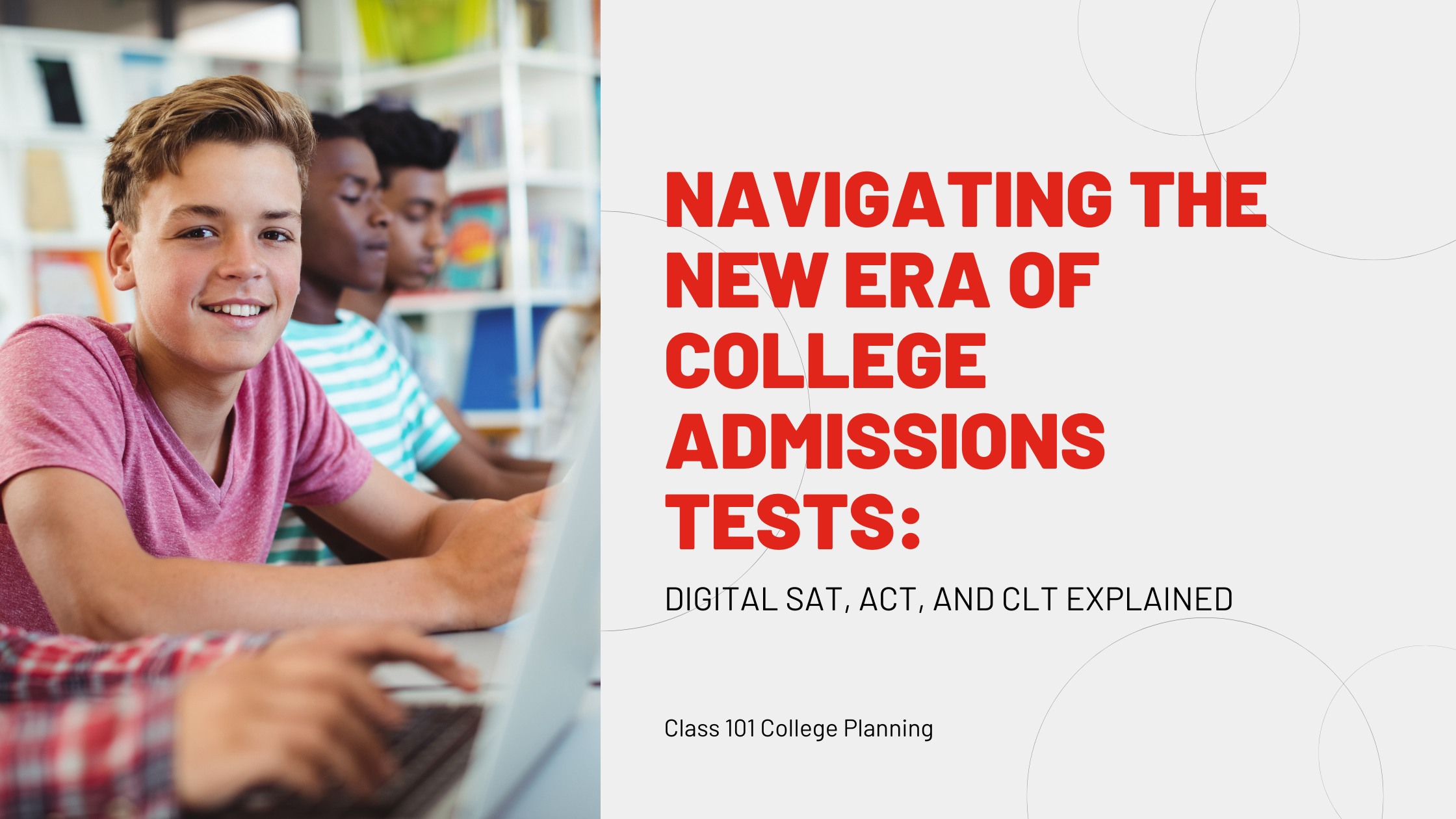March 27, 2024

Navigating the New Era of College Admissions Tests: DIgital SAT, ACT, and CLT Explained
There are few things more closely associated with the college application process than standardized tests. Loved by some, hated by others, standardized tests such as the SAT and ACT are viewed as a way to measure a prospective student’s academic capabilities in a fair and equitable manner.
They are also once-again increasingly unavoidable. While some colleges have gone “test optional” after the pandemic—meaning they did not require students to submit test scores with their applications—growing numbers of colleges have since reinstated the test. As test scores can also have a big impact on financial aid opportunities (as some scholarships require tests), we at Class 101 have always recommended students take exams regardless.
In this blog, we’ll explain some of the most common standardized tests, the SAT, ACT, and CLT. We’ll explain what they are, how they are conducted, and the kinds of schools that use them. By taking advantage of this information and signing up for a meeting with a Class 101 College Advisor, you can make the most of your opportunities available to you.
SAT
The SAT, now sometimes referred to as the Digital SAT due to recent changes, is the standardized test that most people are familiar with and used by the most colleges to inform their admissions decisions. The College Board, the organization that runs the test, claims it “represents more than a century of work by colleges and educators to create a single entrance exam that is fair to all test takers.” Though accepted by colleges around the country, it is particularly prominent on the East and West Coast.
The SAT is usually offered seven times a year: March, May, June, August, October, November, and December. It costs $60 to register (though some students are eligible for fee waivers) and is two hours and 14 minutes long, not counting a 10-minute break.
64 of those minutes are reserved for reading and writing (which can include questions on writing craft, expressions of ideas, and information and ideas) and an additional 70 minutes for math (which can include algebra, advanced math, data analysis, and geometry and trigonometry).
Each SAT is scored out of 1600 points, with 800 reflecting reading and writing ability and 800 reflecting math. Scores range from 400 to 1,600. In 2019, the average SAT score was 1050, with 1350 representing the top 10% of all test-takers.
The SAT has also seen major changes this year. Aside from being shorter in length (past exams took three hours and fifteen minutes), 2024 marks the first year that the SAT has gone completely digital. While students must still go to a public testing center with a proctor in the room, students are able to take the exam on their own laptops or tablets or use school-issued equipment. Throughout the test, students must be connected to the internet and have no other application running in the background. They also will have access to a Desmos Graphing Calculator through the test platform.
The College Board touts these changes as being better for students, making it more accessible, allowing students to work at their own pace, and reducing the ability to cheat through “adaptive” questions. A student’s performance on one reading and writing module will affect the difficulty of questions on the second.
ACT
ACT, by contrast, retains much of the character that it has had over the last 65 years. In the words of ACT Inc., which manages the test, the exam “reflects what students have learned throughout high school and provide colleges and universities with excellent information for recruiting, advising, placement, and retention.” Like the SAT, the ACT is accepted nationwide but is particularly prominent in the Midwest.
The ACT is offered in most US states seven times yearly and corresponds with the school year. Test dates span September, October, November, December, February, April, June, and July. Registration costs either $63 (without the writing exam) or $88 (with writing). The exam itself consists of 215 questions over two hours and 55 minutes (not counting a 15-minute break).
These include 45 minutes for English, 60 minutes for math, 35 minutes for reading, 25 minutes for science, and 40 minutes for an optional essay portion. Questions can test students’ knowledge of language, algebra, data interpretation, and more. They tend to increase in difficulty as students progress through each section. More specific breakdowns of the questions asked can be found on the ACT site.
Unlike the SAT, the ACT is scored out of 36 points, with students scoring between 1 (low) and 36 (high) on each section. A student’s overall “composite score” is the average of the four test scores, rounded to the nearest whole number. Average scores range between 17 and 24. Most colleges that accept the ACT require a minimum score of 18 or 20. Students scoring 25 or higher are considered especially competitive for admissions.
While the ACT CEO announced in 2023 her intention to move the ACT online to make it more inclusive, as of 2024, the exam remains fully in pencil and paper. Students must travel to a testing site, and hand write their answers. They must bring their own calculator for the math section of the exam.
CLT
The Classic Learning Test, or the CLT, is the newest exam and likely the test students are least familiar with. Developed in 2015, it is accepted by only 250 colleges and universities, most of which are small, Christian, faith-based colleges. It recently gained attention when the University System of Florida and other Florida-based colleges announced they would accept it in applications. Its creators claim it fights against the “current trends in American culture and legislation” and is aligned with “traditional education.”
For Juniors and Seniors, the CLT is offered 12 times throughout the year, in August, September, October, November, December, January, February, March, April, May, and June. It costs $59 to register. The exam consists of 120 questions and takes two hours.
The first part of the exam focuses on a “Verbal Reasoning” section made up of topics like religion and “Historical and American Founding Documents.” The second section looks at Grammar and Writing, with topics like philosophy,, science, and “Modern Influential Thinkers.” A third section examines quantitative reasoning, which tests a student’s logical thinking ability. There is a final, optional essay portion. ” A sample exam can be found on its website.
Each section of the CLT is scored between 0 and 40 points, for an overall possible score of 120 points. The average score is roughly 73. A score of 79 is considered to be in the top 18 percent of all CLT test takers and corresponds roughly to a 1210 on the SAT.
The CLT is offered in two formats: online and paper-and-pencil. Either of these formats can be selected while registering, though students will need to check when and where each format is available on the CLT website. Unlike other exams, the CLT also offers a “remote proctoring” version, where students can take the exam at home on their own computers.
***
This blog provides some basic overviews of three exams used for college admissions. We encourage you to look at some of the resources linked in your own time or, for straightforward, personalized guidance, sign up for a meeting with a Class 101 of the Treasure Coast today. Call (772) 247-2716 for more information.

February 14, 2024
It seems that this year, more students than ever got deferred. At the University of Michigan, for example, the number of students who accepted a place on the waitlist increased from 10,080 in 2020 to 18,575 in 2023. This development—born of changes from the pandemic and efforts to increase access—has made the college admissions process even more […]
Read More >
February 2, 2024
It’s been a hectic few years for the Department of Education. In 2020, Congress passed legislation requiring major reforms to the FAFSA. Since then, officials have been trying to design a new, streamlined application form for students. Throughout this time, there’s been several delays, affecting when students will be able to hear about financial awards. It now appears […]
Read More >
April 24, 2023
New FAFSA Delayed for 2023: What to Know The Department of Education announced this month that the release of this year’s Free Application for Federal Student aid—better known as the FAFSA—has been delayed. This will impact the high school Class of 2024 and current college students. While this announcement might confuse many who are applying […]
Read More >